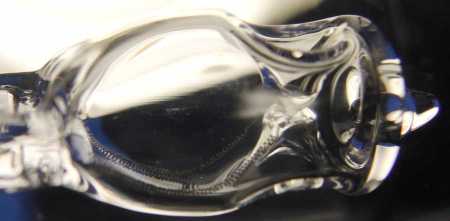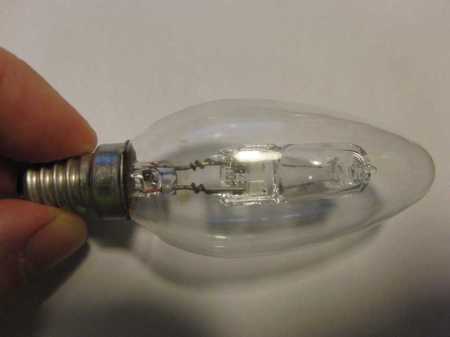I have just replaced a light fitting in our living room in which light bulbs of every type failed to thrive:
- Conventional light bulbs would blow after a couple of weeks;
- Compact fluorescent bulbs would fade prematurely;
- And even expensive halogen bulbs dimmed, and then died.
What was going on? Well, I think the answer has to do with temperature and gravity. As evidence, I present a picture of a failed halogen light bulb which I examined after I had removed it from the fitting. The key feature of the fitting was that it held three light bulbs sideways – and looking at the picture below it is clear that the tungsten elements have sagged until – instead of being isolated in the middle of the inner bulb – they are lying on the surface of the inner bulb. At this point the filaments would be very likely to fail.

Detail of a failed tungsten halogen light bulb. Notice how the filaments have 'sagged' to the point where they lie along the surface of the inner bulb.
But why does the light bulb have that complicated structure with the filament so close to the inner bulb? To answer that I have tell you about the amazing extreme physics that goes on inside these devices. There are 3 key points
- Tungsten-halogen light bulbs run hotter than normal light bulbs – around 2800 °C rather than 2500 °C. This makes them brighter, and converts a larger fraction of electrical energy into light than conventional – colder – light bulbs.
- However, increasing the operating temperature increases the rate of evaporation of the tungsten – which causes darkening of the light bulb – and failure of the filament as it thins to the point where the current density causes it to melt.
- This is where the halogen gas – usually iodine – trapped in the inner bulb comes into operation. If the temperature of the bulb surface exceeds roughly 250 °C – then amazingly the iodine reacts with the deposited tungsten forming WI (No! Not molecules of Women’s Institute! Tungsten Iodide) which is a gas at these temperatures. However, when the WI molecules come close to the heated filament, they decompose and the tungsten is re-deposited on the filament! Wow! Is that a clever trick or what!
In order to keep this tungsten re-cycling working, the inner bulb needs to be rather hot, and so it is kept small, and close to the filament. Normal glass would soften at these temperatures, and so the inner bulb is made of pure silica – silicon dioxide. The outer bulb – made of normal glass (which is silica with impurities such as boron that make it less liable to shatter) is there to prevent anyone touching the inner bulb, and to prevent ultra-violet light from the hotter filament escaping.
References
The Wiki Page for tungsten halogen light bulbs is excellent. But I also strongly recommend the Lamptech Web Pages. They have been written by someone whose love and knowledge of the subject radiates from every sentence on the page. They also have a movie in which iodine is periodically introduced into a light bulb to clear up the deposited tungsten.
Tags: LIght Bulbs, Tungsten Halogen

November 27, 2011 at 9:13 am |
That’s a believable explanation for the WI bulb, but why would conventional bulbs blow and compact fluorescent fade? And aren’t car headlights usually WI in the sideways orientation?
Isn’t your proximity to a mobile phone mast a more likely explanation? 🙂
November 27, 2011 at 3:25 pm |
Reminds me of one Emma’s bulb failures she had on her desk do a while, the filament had sagged and a caused a blister to form on the side of bulb.
Peter
November 27, 2011 at 4:29 pm |
I think there’s an old paper of mine in Metrologia somewhere with a photo of my sideways sagging bulb. I’ll show it to you when I return to work.
There are tungsten halogen bulbs designed for sideways orientation, they are made with a different structure. A bulb designed for upright use will sag if used sideways.
I’m curious about the other lightbulb types too. CFLs are often put sideways in commercial locations (e.g. the toilets and canteen at work – in the ceiling inside reflectors). This is because they send more light sideways than downwards, so operating them that way round is a good idea. Trying to think why yours might last less long? Could they be overheating in that configuration? Anyway, enjoy your new fitting!
November 29, 2011 at 10:00 pm |
I think its to do with voltage. If you consider a wire of lenegth L and radius a and imagine it as a transducer for radiation emission then you equate the power (V^2/R) to the light emitted (Surface area x sigma T^4). Putting in all the numbers for resistivity etc, I get a formula that says that the brightness depends on V/L. So increasing the voltage to 240 V from 12 V, the filament needs to be 20 x longer – and so the danger of sagging increases. I think that’s at the heart of what made the halogen bulbs go.
The problem with CFL’s is temperature – they are designed to cool by convection and when the bulb is not oriented vertically this doesn’t work. Having the ballast circuit in the bulb is just sub-optimal. The CFL’s in our kitchen have functioned perfectly for the last three years – because they have a separate – and very large – ballast circuit that is not heated by the bulb. This is the arrangement in most industrial fittings.